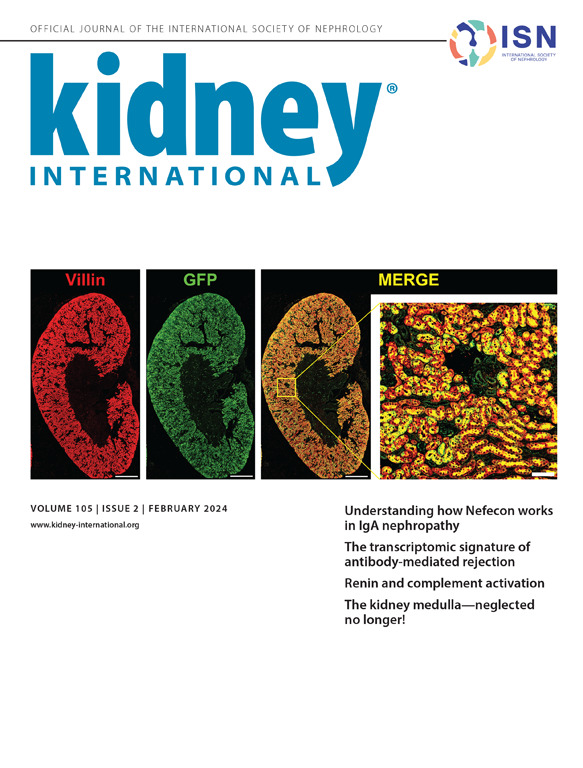Transgenic human nephrin in Drosophila nephrocytes facilitates variant analysis.
IF 14.8
1区 医学
Q1 UROLOGY & NEPHROLOGY
引用次数: 0
Abstract
INTRODUCTION Nephrin, the key structural protein of the slit diaphragm, is encoded by NPHS1. Pathogenic variants in this gene are the primary cause of congenital nephrotic syndrome. About 400 variants have been described but functional characterization in vitro is very limited. METHODS Here, we express human nephrin in Drosophila nephrocytes, which possess a molecularly conserved slit diaphragm to facilitate functional studies. RESULTS Immunofluorescence of the human transgene revealed assembly into a complex linear architecture after silencing of sns, the Drosophila nephrin. This pattern suggests lateral clustering of human nephrin into a macromolecular configuration which resembles nephrin in vivo but is absent in cultured cells. In Drosophila nephrocytes, transgenic nephrin colocalized with the endogenous slit diaphragm proteins Pyd and Kirre, indicating a hybrid multi-protein complex. Transmission electron microscopy with pre-embedding immunogold labeling revealed an atypical, tubular ultrastructure. The linear nephrin did not adequately restore membrane invaginations, endocytic function or cellular survival, suggesting that proper signaling function requires additional indispensable co-factors. Murine Neph1 alone was insufficient but associated with transgenic nephrin. Notably, the linear nephrin assembly provided a read-out for investigation of patient-derived variants. This distinct pattern was altered in transgenes reflecting patient variants with milder clinical presentation, including novel variant NPHS1-V1241G. The impact on the pattern largely correlated with the age of onset of nephrotic syndrome of the respective variant, as demonstrated by automated image annotation for quantitative evaluation. CONCLUSION Our findings demonstrate that transgenesis of NPHS1 in nephrocytes is a viable approach for investigation of slit diaphragm formation and precise functional characterization of patient variants.在果蝇肾细胞中转人肾素有利于变异分析。
nephrin是狭缝隔膜的关键结构蛋白,由NPHS1编码。该基因的致病变异是先天性肾病综合征的主要原因。已经描述了大约400种变体,但体外功能表征非常有限。方法在果蝇肾细胞中表达人肾素,使其具有分子保守的狭缝隔膜,便于功能研究。结果人类转基因基因的免疫荧光显示,在果蝇肾素沉默后,该基因组装成一个复杂的线性结构。这种模式表明,人肾素横向聚集成一个大分子结构,类似于体内的肾素,但在培养细胞中不存在。在果蝇肾细胞中,转基因肾素与内源性裂膜蛋白Pyd和Kirre共定位,表明是一种杂交多蛋白复合物。预包埋免疫金标记的透射电镜显示非典型的管状超微结构。线性肾素不能充分恢复膜内陷、内吞功能或细胞存活,这表明正常的信号功能需要额外的不可或缺的辅助因子。小鼠单独使用Neph1是不足的,但与转基因肾素相关。值得注意的是,线性肾素组装为研究患者衍生的变异提供了读数。这种独特的模式在转基因中被改变,反映了临床表现较轻的患者变体,包括新变体NPHS1-V1241G。正如用于定量评估的自动图像注释所证明的那样,对模式的影响在很大程度上与各自变异的肾病综合征发病年龄相关。结论在肾细胞中转染NPHS1是研究狭缝横膈膜形成和精确描述患者变异的一种可行方法。
本文章由计算机程序翻译,如有差异,请以英文原文为准。
求助全文
约1分钟内获得全文
求助全文
来源期刊

Kidney international
医学-泌尿学与肾脏学
CiteScore
23.30
自引率
3.10%
发文量
490
审稿时长
3-6 weeks
期刊介绍:
Kidney International (KI), the official journal of the International Society of Nephrology, is led by Dr. Pierre Ronco (Paris, France) and stands as one of nephrology's most cited and esteemed publications worldwide.
KI provides exceptional benefits for both readers and authors, featuring highly cited original articles, focused reviews, cutting-edge imaging techniques, and lively discussions on controversial topics.
The journal is dedicated to kidney research, serving researchers, clinical investigators, and practicing nephrologists.
 求助内容:
求助内容: 应助结果提醒方式:
应助结果提醒方式:


